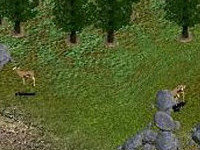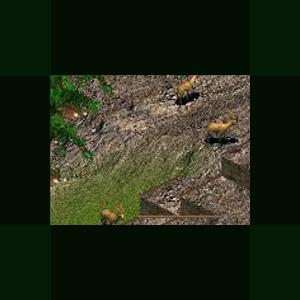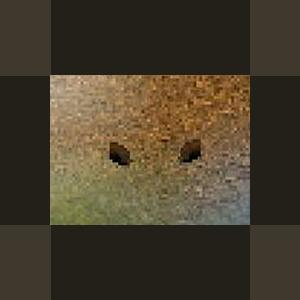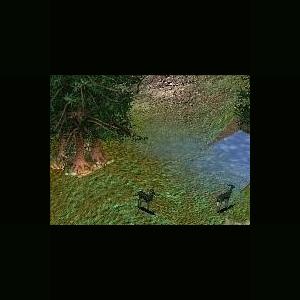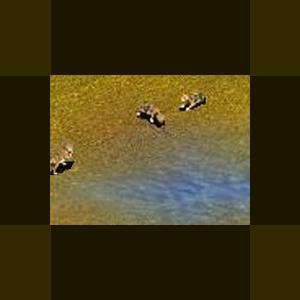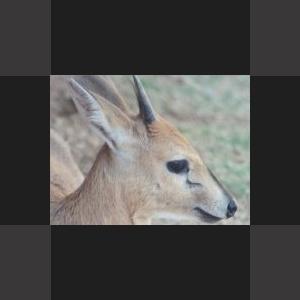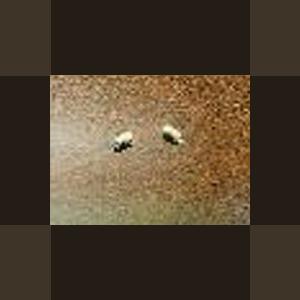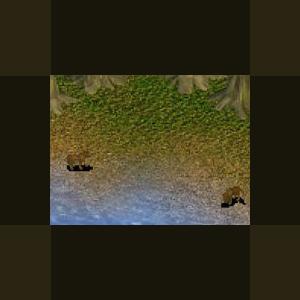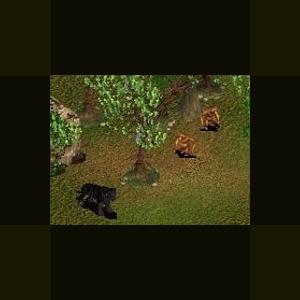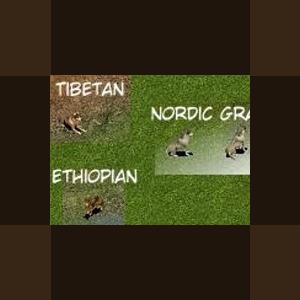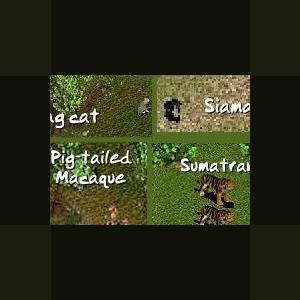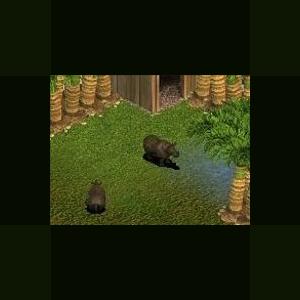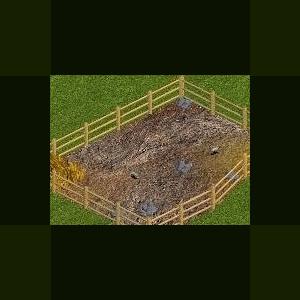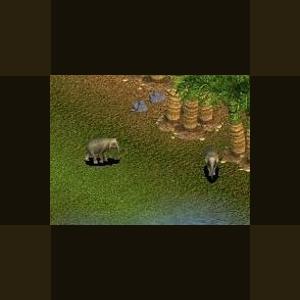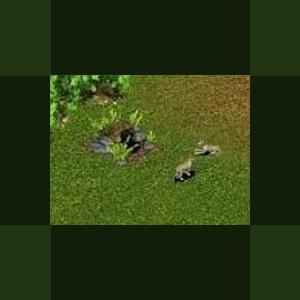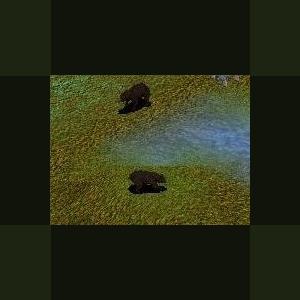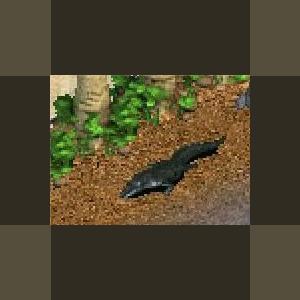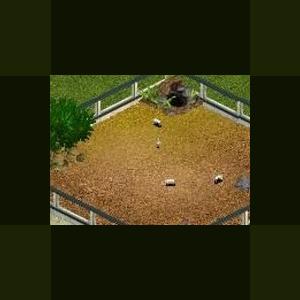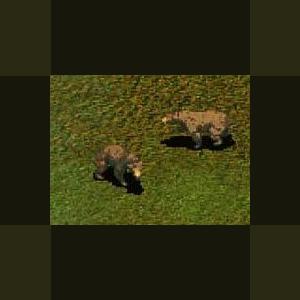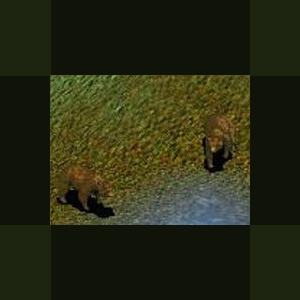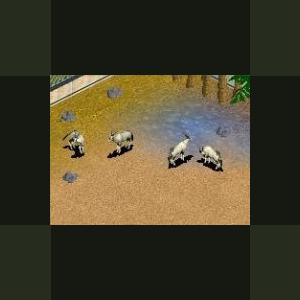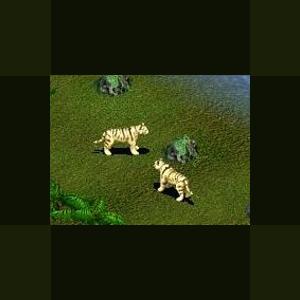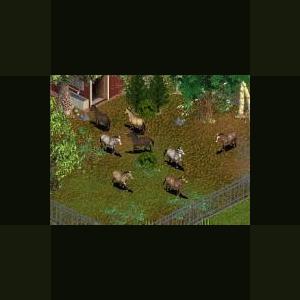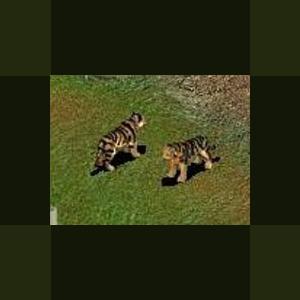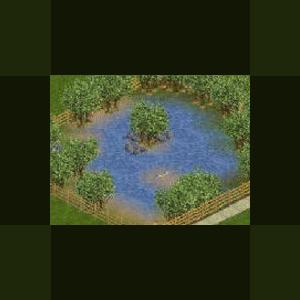279 files
-
Cuvier's Gazelle by Ghirin
By Guest
Cuvier's gazelle (Gazella cuvieri) is native to North Africa and is the only antelope that is currently endemic to the area north of the Sahara Desert. At one time, Cuvier's gazelle was widespread in the Atlas Mountains of North Africa and was also called the Atlas or Edmi gazelle. Currently, its range has been markedly reduced by hunting to scattered populations in the highlands of Algeria, Morocco and Tunisia.
Cuvier's gazelle can be found in highland oak and pine forests, mountain meadows, and even desert plateaus. It will feed on both grass and shrubs, depending on the season. The gazelle prefers to stay in the hills during the day, and will descend into the valleys at dawn and dusk to feed. It needs water from waterholes in addition to dew and plant moisture to survive.
Created by Ghirin 2003
Updated 2010-10-30
Just to save space with less in zip and smaller image.
Nothing new.
Updated August 18, 2018 by Cricket so that screenshot would show up again.
362 downloads
0 comments
Updated
-
Siberian Ibex by Ghirin
By Guest
The Siberian Ibex (Capra sibirica, Capra ibex sibirica) is a heavy-bodied wild caprid found in the mountain ranges of Central Asia, from the inner Himalayas to Mongolia. Like other wild goats, Siberian ibex prefer the higher elevations (up to 5000 meters), usually climb down to lower elevations during winter months.
This ibex is stout-bodied when compared to other species of wild goats. The fur color is variable, but is generally light tan and lacks the contrasting black and white markings on the legs. Both sexes have horns, with the horns of the males being much heavier, having several knobs on the front, and often curving backwards in pronounced arcs.
Siberian ibex are gregarious animals. Adult females and their young gather in herds of seven to thirty animals. Males form bachelor herds of similar sizes. Most feeding activity occurs during early morning and late afternoon.
Created by Ghirin 2003
Updated 2010-11-06
Just to save space with less in zip and smaller image.
Nothing new.
225 downloads
0 comments
Updated
-
Brown Lemming by Ghirin
By Guest
The brown lemming (true lemming. genus Lemmus) is a small, stout-bodied rodent native to the tundra and boreal areas of the northern hemisphere. They are solitary, living in underground burrows and only coming together for reproduction. They prefer flat, meadow-type habitats and eat greestuff such as grass, bark, moss, lichens and roots.
Brown lemmings are active throughout the year, but their fur does not change to white during the winter.
Brown lemmings are prolific rodents and major increases in populations are recorded regularly. These increases in populations may leave to migration of animals in search of suitable habitat.
Created by Ghirin 2003
Updated 2010-10-30
Just to save space with less in zip and smaller image.
350 downloads
0 comments
Updated
-
Tufted Deer by Jordan
By Guest
Deer from the mountain forests of Asia
Updated 2010-11-11
Just to save space with less in zip and smaller image.
Nothing new.
347 downloads
0 comments
Updated
-
North African Wildcat by Ghirin
By Guest
The wildcat (Felis sylvestris) is widespread throughout Africa and Eurasia. The species is divided up into three main groups based on geographic location: Lybica from Africa, Sylvestris from Europe, and Ornata from Asia. In turn these three groups are further divided into subspecies.
The African wildcat is found throughout Africa except in areas of true desert. The species is solitary. Males often control a territory containing several smaller territories that are controlled by individual female wildcats. They hunt during the night, late evening, and early morning, preying mainly on small rodents. Other small animals such as rabbits, insects, birds, and small reptiles are also hunted.
Updated 2010-11-04
Just to save space with less in zip and smaller image.
Nothing new.
388 downloads
0 comments
Updated
-
Common Duiker by Jordan
By Guest
Body Length: 80-115 cm / 2.6-3.8 ft.
Shoulder Height: 45-60 cm / 1.5-2 ft.
Tail Length: 10-20 cm / 4-8 in.
Weight: 10-20 kg / 22-44 lb.
The coat is generally pale reddish-brown to grizzled gray, depending on the geographical location. The undersides are whitish, while the muzzle, nose bridge, and forelegs are black. The short tail is black on the top, contrasting sharply with the fluffy white underside. The long, pointed ears are separated by a tuft of hair on the forehead. Females are usually larger than males. The sharply pointed horns are usually found only in males and grow 7-18 cm / 3-7 inches long. The horns are more vertically oriented than in other duiker species, due to the more open habitat.
Gestation Period: 6-7 months.
Young per Birth: 1
Weaning: 2 months.
Sexual Maturity: Females at 8-10 months, males at 12 months.
Life span: Up to 14 years.
After birth, the young lie up in dense cover for a number of weeks.
Feeding predominantly from dusk until dawn, the gray duiker rests in favourite hiding places in scrub or grass during the day. This small antelope has exceptional speed and stamina, and is usually able to outrun dogs that chase after it. The home ranges of individuals of the same sex rarely overlap. However, there is substantial common land in the ranges of individuals of the opposite sexes. Males are territorial, marking their defended areas with preorbital secretions and attacking other males that intrude. The favourite resting place of these males is a high spot overlooking their territory. In favourable areas there are approximately 2 animals per square kilometer. Juveniles make a loud bleat if caught, which brings the parents running.
Family group: Usually solitary, although pairs are occasionally sighted.
Diet: Tree and bush foliage, fruits, seeds, occasionally carrion.
Created by Jordan, Zoo Tek Designer, 2005
Inspired by the Zoo Tycoon Brains Trust at Zoo Tek
Updated 2010-10-30
Just to save space with less in zip and smaller image.
Nothing new.
368 downloads
0 comments
Updated
-
Collared Lemming by Ghirin
By Guest
The collared lemming (varying lemming, genus Dicrostonyx) is a stout-bodied rodent native to the tundra regions of the northern hemisphere. The fur of lemmmings of this genus change color between seasons, from dark in summer to white in winter, making this the only rodent in the world with a coat that changes to white in the winter. The collared lemming also develops a double claw during the winter to aid it in digging through snow and ice during the winter.
Collared lemmings dig and dwell in burrows, using the tundra sod and snow as digging substrate. Their burrows can reach up to 6 m in length and be 20 cm wode. A nest burrow is usually found at the end of the tunnel.
Collared lemmings live in treeless tundra and are active year-round. In the wild, they eat grass, flowers, fruit, sedeges, and bush stems.
These lemmings are prolific and surges in local populations have been recorded followed by “crashes”.
Created by Ghirin 2003
Updated 2010-10-30
Just to save space with less in zip and smaller image.
Nothing new.
331 downloads
0 comments
Updated
-
South American Bush Dog by Ghirin
By Guest
The bush dog (Speothos venaticus) of South and Central America is a very unusual canine.
It has a long body on short legs. Bush dogs inhabit rainforests and wet savannahs of that region. They are excellent hunters and also will pursue prey into the water.
Bush dogs are very social animals, living and hunting in packs of up to 10 individuals. They are among the most carnivorous of all canines. Their main prey animals are rodents such as pacas and agoutis.
Updated 2010-11-06
Just to save space with less in zip and smaller image.
Nothing new.
314 downloads
0 comments
Updated
-
Sumatran Cryptids by Jordan
By Guest
Sumatran Cryptids by Jordan
The Orang Pendek and Cigau cryptids of Sumatra, combined into one ztd.
Cigau
The Cigau is a Sumatran mystery wild cat described as a cross between a lion and a tiger. Described as being slightly smaller, but apparently more heavily built, than the Sumatran tiger, they are greatly feared by the hunters of Kerinci--the only animal to produce such a reaction. They claimed the cigau attacks without provocation. "Cigau hates man".
Animal recolor and programming by Jordan, stat change and research by Genkicoll.
Orang Pendek
The orang pendek is an orangutan-like cryptid from the island of Sumatra.
The orang pendek is fully compatible with the orangutan for those inclined to making mixed exhibits.um
Updated 2010-11-06
Just to save space with less in zip and smaller image.
Nothing new.
212 downloads
0 comments
Updated
-
Wolf Pack ll by Jordan and Ryno
By Guest
Three wolves for your zoo:
The Tibetan wolf, Nordic Gray, and Ethiopian wolf
Updated 2010-11-11
Just to save space with less in zip and smaller image.
Nothing new.
344 downloads
0 comments
Updated
-
Sumatran Animals by Tek Design
By Guest
Four Sumatran animals:
Fishing cat, Siamang, Pigtailed Macaque, and Sumatran Tiger
Updated 2010-11-06
Just to save space with less in zip and smaller image.
Nothing new.
390 downloads
0 comments
Updated
-
Sumatran Rhino by Jordan
By Guest
Also known as the "hairy rhino," the Sumatran rhinoceros is among the world's most endangered mammals..
In the past 10 years, almost 50 percent of these rhinos have been lost to poaching. Now less than 300 survive in isolated pockets in Southeast Asia. Besides being the only rhino with hair on its body, the Sumatran rhino is also the only two-horned species in Asia. It has rarely been seen because of the dense rainforest and moss forest where it lives. This rhino is considered a descendant of the prehistoric woolly rhinoceros, depicted in Stone Age cave drawings in Europe.
Updated 2010-11-06
Just to save space with less in zip and smaller image.
Nothing new.
500 downloads
0 comments
Updated
-
Rock Hyrax by Jordan
By Guest
The Rock Hyrax is a small African mammal that lives in large groups on rock outcroppings.
Updated 2010-11-05
Just to save space with less in zip and smaller image.
Nothing new.
324 downloads
0 comments
Updated
-
Sumatran Elephant by Jordan
By Guest
Sumatran elephants are the smallest of the Asian elephants. Males rarely develop long tusks, while those of adult females may be so short that they are hidden by the upper lip. This elephant can live up to 70 years in captivity, less in the wild.
The endangered Sumatran elephant (Elephas maximus sumatranus) is the smallest (and perhaps oldest) of the Asian subspecies and is unique to the island of Sumatra. It has been protected in Indonesia since 1931. Population surveys conducted in the 1980’s estimated that only 2800 – 4500 wild elephants remained. It is likely that even fewer survive in today’s fragmented forests. The term "pocket elephants" was originally coined to refer to their diminutive size, and also reflects their survival today in the few remaining "pockets" of lowland rainforest.
The combined effects of road development, logging, conversion of forest to agriculture, and human resettlement have contributed to the loss of thousands of hectares of elephant habitat. As habitat shrinks, elephants are forced into conflict with humans. The destruction of crops and houses results in injuries and deaths of both humans and elephants.
Villagers faced with raiding elephants demanded that the government resolve the problem. To these villagers, the elephants were just dangerous crop-raiding pests. Occasionally, angry villagers have poisoned elephants. Unlike other Asian countries, with strong elephant traditions, elephants are not revered in Indonesia.
The government of Indonesia began establishing Elephant Centers on Sumatra in 1986 in an attempt to relieve human-elephant conflicts. Today there are six Centers that hold approximately 400 elephants.
Updated 2010-11-06
Just to save space with less in zip and smaller image.
Nothing new.
366 downloads
0 comments
Updated
-
Swift Fox by Ghirin
By Guest
The swift fox (Vulpes velox) is found in the open grasslands and dry regions of North America. It is nocturnal, preferring to stay in underground burrows during the day.
Swift foxes prey on rodents and rabbits and live in monogamous pairs.
Reference:
http://www.lioncrusher.com/animal.asp?animal=33
Created by Ghirin 2008
Updated 2010-11-06
Just to save space with less in zip and smaller image.
Nothing new.
306 downloads
0 comments
Updated
-
Cinnamon Bear by Ghirin
By Guest
A beautiful color phase of the black bear that will look great in any zoo.
Cinnamon bears prefer to live alone or in small groups.
Cinnamon bears like to sleep in rock caves.
Updated 2010-10-30
Just to save space with less in zip and smaller image.
Nothing new.
250 downloads
0 comments
Updated
-
Black Caiman by Ghirin
By Guest
The black caiman (Melanosuchus niger) is found throughout the Amazon River basin. Both hunting and loss of habitat have severely impacted the population.
References:
http://www.flmnh.ufl.edu/cnhc/csp_mnig.htm
www.wikipedia.com
Created by Ghirin 2008
Updated 2010-10-30
Just to save space with less in zip and smaller image.
587 downloads
0 comments
Updated
-
Naked Mole Rat by Jordan
By Guest
Naked Mole Rats are African rodents which live in burrows and can thrive in small exhibits.
Updated 2010-11-04
Just to save space with less in zip and smaller image.
Nothing new.
389 downloads
0 comments
Updated
-
Blond Bear by Ghirin
By Guest
The blond bear is a color phase of the American black bear. This particular color phase is most common in the western portion of North America and is thought to be due to the more open habitat of that region. Brown, black, and cinnamon “black” bears are also found in the same regions as blond bears.
Blond bears have the same habitat needs as regular black bears. It is compatible with black, cinnamon, and glacier phases of the American bear.
Updated 2010-10-30
Just to save space with less in zip and smaller image.
249 downloads
0 comments
Updated
-
Eurasian Brown Bear by Ghirin
By Guest
The Eurasian brown bear is the Old World population of Ursus arctos, equivalent to the grizzly and Kodiak bears of North America. These bears have considerable size range, from the small bear of southern Europe to the giant bears of the Kamchatka peninsula (eastern Siberia). Likewise, the fur has a wide range of color, from blonde to almost black.
The brown bear has adapted to many of the habitats found on the Eurasian continent, including the dry environment of the Gobi desert and the mountain ranges of southern Asia. Populations have been recorded in Russia, Scandinavia, Eastern Europe, China, the Himalayas, Turkey, and Hokkaido. Small, isolated populations have also been found in continental Western Europe.
Brown bears have a varied diet. They usually eat what is most available at the time. Spring foods include grasses, sedges, moss and roots while later in the year, berries become more important. Other foods such as insects, fungi, and meat are eaten when available. In areas where there are salmon runs, bears will harvest salmon as the fish make their way up rivers to spawn.
Late fall is the time that brown bears seek out dens for hibernation. The bear might dig its own den, and then make a bed of dry vegetation. During hibernation, there is a significant depression in the bear's hear rate and respiration. However the bear can be easily roused if it needs to escape from danger.
Created by Ghirin 2003
Updated 2010-11-03
Just to save space with less in zip and smaller image.
Nothing new.
329 downloads
0 comments
Updated
-
Arabian Oryx by Jordan
By Guest
Arabian Oryx by Jordan
The Arabian Oryx is a highly endangered antelope living in the barren steppes, semi-deserts, and deserts of the Arabian peninsula. Only a few hundred remain in the wild.
Updated 2010-10-30
Just to save space with less in zip and smaller image.
Nothing new.
438 downloads
0 comments
Updated
-
Bali Tiger by Moondawg
By Guest
Bali Tiger by Moondawg 2009
The Bali Tiger (Panthera tigris balica), harimau Bali in Indonesian, or referred to as samong in archaic Balinese language, is an extinct subspecies of tiger found solely on the small Indonesian island of Bali. This was one of three sub-species of tiger found in Indonesia along with the Javan tiger (also extinct) and Sumatran tiger (critically endangered).
It was the smallest of the tiger sub-species; the sub-species was declared extinct on September 27, 1937 after a tigress was shot at Sumbar Kima, west Bali. Given the small size of the island, and limited forest cover, the original population could never have been large, and it is considered unlikely that any survive today.
The subspecies became extinct due to habitat loss and hunting.
Weight
This subspecies was the lesser sized of all tigers, rather comparable with the African leopard or North American cougar in size.
The weight of a male tiger was usually 90-100 kg (198-221 pounds).
Females weighed in at 65-80 kg (142-175 pounds).
Length
A male Bali tiger's length was around 7'-4" to 7'-7".
A female's length was around 6'-3" to 6'-5".
Appearance
Bali tigers had short fur that was deep orange colored and darker, fewer stripes than other tiger sub-species. Occasionally, between the stripes, there were small black spots. Bali tigers also had unusual bar-shaped patterns on the head.
Life
Balinese tigers lived up to approximately 8-10 years of age.
Prey/Predators
The only known predators of Bali tigers were humans. Like all tigers, the Bali tigers were carnivorous. The Bali tigers preyed upon most mammals that lived within their habitat.
Cubs
Female Bali tigers, after mating, had a gestation period of 103 days on average. They begat two or three cubs each mating, and the cubs weighed two or three pounds at birth. They were born blind. Cubs became weaned at around one year of age, and were fully independent at 18 months to two years of age. Sometimes the cubs stayed with their mother for another year.
Documentation, hunting and tiger culture in Bali
In Balinese culture, the tiger had a special place in folk tales and traditional arts, like the Kamasan paintings of Klungkung kingdom. However, they were perceived as a destructive force and depredation efforts were encouraged all the way to the time of extinction. Very few reliable accounts of encounters and even less visual documentations remain. One the most complete recordings was made by the Hungarian baron Oszkár Vojnich, who trapped, hunted and even took photos of a Balinese tiger. On November 3, 1911 he shot dead an adult specimen in the northwest region, between Gunung Gondol and Banyupoh River, documenting it in his book "In The East Indian Archipelago", Budapest 1913. [4] According to the same book, the preferred method of hunting tigers in the island was catching them with a concealed, large and heavy steel foot trap over bait (goat or muntjak) and then dispatching it with a firearm at close quarters.
As in this example, a final blow to the ever low numbers of island's tiger population was during the Dutch colonial period, when shikari hunting trips were conducted by European sportsmen coming from Java Island, armed with high power rifles and Victorian Era romantic but disastrous hunting mentality, like Surabayan gunmaker E. Munaut, who is confirmed with killing over twenty tigers in Bali, over few years span.
The last confirmed tiger was an adult female, killed on Sep. 27, 1937 at Sumbar Kima, western Bali; since then, claims of sighting were made, but without proof, mostly by forestry officers in years 1952, 1970 and 1972. The last remaining tigers were pushed into western side, mostly into area that is now Bali Barat National Park, established for but too late to save the tigers, in 1947, but not too late for other endangered animals like the endemic Bali starling (Leucopsar rothschildi). Chances tigers survived without being observed are virtually impossible with the publicity, technology and growth of population and mass tourism in this island today.
The Balinese tiger, sadly, never got to be captured on film alive, on motion picture or displayed in a public zoo, but few skulls, skins and bones are preserved in museums. British Museum in London has the largest collection with two skins and three skulls, others include Senckenberg Museum in Frankfurt, Naturkunde Museum in Stuttgart, Naturalis museum in Leiden and Zoological Museum of Bogor, Indonesia, who owns the remnants of the last known Balinese tiger ; in 1997 a skull emerged from the old collection of Hungarian Natural History Museum and was scientifically studied and properly documented.
Unlike stag hunting, which they mastered, very few if any Balinese launched into stalking tiger, whom aside from danger, was shone upon by malefic superstitions. Still, tigers had a well defined position in folkloric beliefs and magic. For example, the Balinese considered ground powdered tiger whiskers to be a potent and undetectable poison for one's foe. According to the same book mentioning this, Miguel Covarrubias "Island Of The Gods", 1937, when a Balinese baby was born he was given a protective amulet necklace with black coral and "a tiger's tooth or a piece of tiger bone".
Like other Asian nations, many Balinese people are fond of wearing tiger parts jewelry, for status or spiritual reasons like power and protection and necklaces of teeth and claws or male rings cabochoned with polished tiger tooth ivory still exist on everyday use. As tiger population disappeared on both Bali and neighboring Java, old parts are recycled or leopard and sun bear parts are used instead.
Updated 2010-10-30
Just to save space with less in zip and smaller image.
Nothing new.
605 downloads
0 comments
Updated
-
European Horse Pack singles by Genkicoll
By Guest
Four European horses made to be compatible with the Forest Tarpan by Ghirin.
Turkmen Akhal-Teke Horse
The Akhal-Teke horse breed (pronounced Ah-cull Tek-y) is a breed from Turkmenistan, where they are the national emblem. It is named after the nomadic tribe that bred them. They are racehorses, noted for their endurance on long marches and are thought to be the predecessors of the Arabian and English thoroughbred breeds. These beautiful "golden-horses' are adapted to severe climate conditions and are thought to be one of the oldest surviving horse breeds. There are currently about 3,500 Akhal-Tekes in the world, mostly in Turkmenistan and Russia, although they are also seen in Germany and the United States.
Alexander the Great's horse, Bucephalus, is said to have been an Akhal-Teke.
Breed characteristics
The Akhal-Teke's most notable and defining characteristic is the natural metallic bloom of its coat. This is especially seen in the palominos and buckskins, as well as the lighter bays, although some horses "shimmer" more than others, and is thought to have been used as camouflage in the desert, where the heat causes the desrt to shimmer. Also noteworthy are the breed's almond-shaped eyes. The breed is very tough and resilient, due to the harshness of the Turkmenistan lands, living without much food or water. This has also made the horses good for sport. The breed has great endurance, shown in 1935 when a group of Turkmenian horsemen rode the 2500 mile journey from Ashgabat to Moscow, which lasted 84 days, and included a 3 day desert crossing of 235 miles without water.
The horses have a fine head with a straight or slightly convex profile, and long ears. The mane and tail is usually sparse. Their long back has little muscle, and is coupled to a flat croup and long, upright neck. The Akhal-Teke possesses a sloping shoulder and thin skin. These horses have strong, tough, but fine limbs, although the hind legs are sometimes sickle-hocked. They have a rather shallow body with a shallow ribcage (like an equine greyhound), although a deep chest, and this shallowness continues to the back of the frame. The conformation is not considered "good" by Western terms, but that is made up by the breed's great beauty, and tremendous athletic ability.
The Akhal-Tekes are brave riding horses, lively, and alert, but are known to be obstinant and rebellious at times. They are generally a one-rider horse.
The horses are usually a pale golden color (like honey) with black points. They can also be bay, black, chestnut, or gray. The Akhal-Teke usually stands between 14.3 and 15.2 hh.
Chestnut Goklan Horse
The Goklan horse is, with the exception of the Yabou, the "heaviest" descendant of the old Turanian horse. He was bred in the main by the Goklan Turkoman, whose tribal borders are within Iran. As a result of the needs they had for their horse, the horse is well suited to mountainous terrain.
Breeders of Turkomans in Iran note that some Akhal-Teke foundation sires bear a strong resemblance to the Goklan horse they breed today. Curiously enough, some Arabian horses also bear a strong resemblance to the Goklan: the famous Polish Arabian sire Wielki Szelm (left) bears a very strong resemblance to Akhal-Teke foundation sire Dor Bairam (right). The Arabian has a higher tail-set and shorter back, accommodations to their differing terrain. Otherwise, in overall conformation, they are both much like a heavyweight Thoroughbred hunter.
Russian Arabian Dun Horse
The modern Russian Arabian breeding program was thus begun in 1930 at Tersk. Ever since the stud has accumulated much experience and produced dozens of superb individuals.
In 1930 the gray Koheilan IV was bought in Hungary, and from France came six pure–blood Arabian mares and a stallion. In 1939 from England came 6 Arabian stallions and 19 mares.
In 1939 a large group of Arabians arrived from Poland, and 9 more Arabian mares from Germany were added to the Tersk stock in 1947.
In March 1976 a WAHO commission visited Tersk. It confirmed the high quality of the stock there and recognized the pure–blood origins of all the horses except for Amara and Basma imported from Egypt in 1973.
In 1986 some stock was transferred to Khrenovoe, the stud founded by Count Orlov. The Arabian department at Khrenovoe is quite successful. The Khrenovoe horses compete with the Tersk Arabians on the track.
White Yabou Horse
The Yabou (sometimes spelled "yaboo") is the pack horse of the peoples on the Turkoman steppes. Some older references use "Yabou" in terms of "the horse of the people, a pack horse, a nag," but the Yabou is much more than that. The Yabou is every bit as hardy and enduring as the other Turkoman strains, and differs from them only slightly. There is a copious mane to go with the generous tail. The neck is set on lower than that of the Teke, Yamout or Goklan. The horse is somewhat less narrow than other Turkomans, and typically shorter. The shoulders especially are powerful. All in all, this is a horse built to carry weight over a distance, at speed. (Sometimes his job was to run behind the Turkomen horses, carrying their heavy felts). He often ambles and paces with fantastic speed.
Preliminary blood test results performed at the University of Kentucky show that the English Thoroughbred is more closely related to the Yabou than to either the other Turkoman breeds/strains or the Arabian in terms of shared genetic markers. That this ubiquitous "utility" horse would have a closer association to the Thoroughbred than other "thoroughbred" horses has come as somewhat of a surprise, but perhaps it should not. From the photo above (taken by Farshad Maloufi and used here with his permission), one can see that the Yabou is not at all lacking in quality.
The Yabou comes in the complete range of colors found in the Turkoman and Caspian horse.
The Turkoman do not breed Yabous themselves, although they use them extensively for pack horses. Rather, they buy them from gypsies who live in the more forested areas of the mountains. The Yabou probably always shared the range of the Turanian Thoroughbred, and was much more numerous; the Pazyryk kurgans each contain only a single Turanian but as many as a dozen or more Yabous.
Updated 2010-11-03
Just to save space with less in zip and smaller image.
Nothing new
503 downloads
0 comments
Updated
-
Trinil Tiger by Moondawg
By Guest
Trinil Tiger
The Trinil Tiger (Panthera tigris trinilensis) is a fossil tiger dating from about 1.2 million years ago. This tiger was found at the locality of Trinil, Java, Indonesia. These fossils are now stored in the Dubois Collection of the National Museum of Natural History in Leiden, the Netherlands. Although these fossils have been found on Java, the Trinil tiger is probably not a direct ancestor of the Javan tiger. The Trinil Tiger probably became extinct fifty thousand years ago.
Updated 2010-11-11
Just to save space with less in zip and smaller image.
Nothing new.
369 downloads
0 comments
Updated
-
Dragonfly by African Raptor
By Guest
Dragonfly is a kind of insect. It belongs to the Order Odonata and the Class Insecta. The family is True bugs. Given its large claw-like pinchers, the dragonfly is a predator and feeds on other organisms.
You can recognize a dragonfly nymph by its teardrop shaped abdomen. It also has very large eyes.
There are about 5,300 species of dragonflies around the world. It is an insect that has two pairs of thick and long wings.
It lives near fresh water (usually slow moving) and swamps. It spends its childhood in water. Dragonflies are not harmful to people, though are smart hunters. They can fly up to 60 mph and live for 2-5 years average.
For four years, dragonflies are in a young time when they live under the water. For one year they are an adult dragonfly.
Dragonflies have been around for 300 million years. In old prehistoric times dragonflies had wings that were over two feet wide.
Dragonflies can eat water insects as larvae, but as they grow older they eat tadpoles, small fish (really small fish), and even their own species.
Updated 2010-10-30
Just to save space with less in zip and smaller image.
Nothing new.
386 downloads
0 comments
Updated

